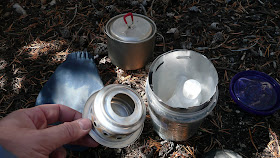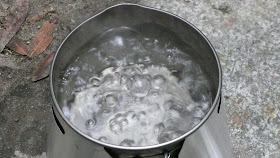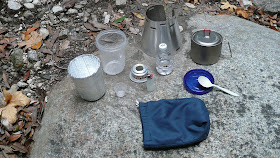Recently, I did
a review of the Caldera Cone alcohol stove system, which is a wonderfully efficient, lightweight, wind resistant alcohol stove system, one of the best out there.
 |
| A Caldera Cone alcohol stove system in use with an MSR Titan kettle. |
Today, I thought I'd take a quick look at the unique burner that comes with the Caldera Cone, the 12-10 burner. As for why the Caldera Cone is such an efficient alcohol stove system, please see
The "Magic" of the Caldera Cone.
 |
| A Caldera Cone's 12-10 burner, shown here in my hand. |
The 12-10 burner has an interesting and unusual design. While the 12-10 has holes in the side of the body of the burner, it is not a side jet stove, at least not in the conventional sense.
 |
| Some common alcohol stove designs: Open cup side burner, closed top jet, open top jet (including the brass Trangia burner) |
With a typical side jet burner, the flames burn
out from the jets.
 |
| A typical side jet burner. |
With a 12-10 burner, the flames from the "jets" basically burn
in to the burner. It's a little hard to see, but take a close look at the two photos below of a 12-10 burner. If you look closely, you can see the jets burning within.
 |
| A 12-10 burner in use. Can you see the jets within the burner? |
 |
| Another photo of a 12-10 burner in use. Can you see the interior jets any better in this photo? |
The interior jets combine into one flame and exit the burner, burning as though the 12-10 burner were a simple open cup type burner. It's anything but. This is one sophisticated, well-tuned burner. I can only imagine how many hours of design, building, and testing went into the 12-10!
 |
| The 12-10 burner almost looks as though it were a simple open cup type burner. Note the burner is shown mounted in a Trangia 27 set up for ease of photography. The Trangia 27 is NOT a Caldera Cone or a Trail Designs product. |
Now, take a look at that photo above. That's a really tall flame. On most stoves, if you get a tall flame like that, the stove is really inefficient and burns through its fuel quickly. Not the 12-10. In test after test, I've matched it up against various designs, and relatively few stoves beat the 12-10 in a duration test.
 |
| Various alcohol stoves being compared to 12-10 burners in a duration test. Can you spot the 12-10 burners? They're the two on the lower right hand side, front row. |
One might also think that such a tall flame would waste a lot of heat. Not so with a Caldera Cone
 |
| A Caldera Cone (left) |
That cone controls the airflow around the pot and transfers heat to the pot very efficiently with a minimum of fuel use.
 |
| Water boiling on a Caldera Cone stove system. |
The Caldera Cone alcohol stove system -- it's one well thought out system.
 |
| My Caldera Cone alcohol stove system set up. |
And at it's center? The superb, lightweight 12-10 burner. Highly recommended.
HJ
P.S. This blog post is part of my series on the Caldera Cone. In case you missed any of the series:
 |
| A Trail Designs 12-10 alcohol burner |
Related posts and articles:
Jim,
ReplyDeleteAfter reading your reviews of the Caldera Cone system I went to their website and see that there's a gassifier/afterburner setup for this thing! How cool is that? Have you had a chance to try this out? Aside from USFS regulations and the slight environmental impact of scavenging your fuel from the trail, the thought of not carrying any (or minimal) fuel is intriguing. A friend of mine once had one of those Sierra Stoves that were set up like a mini-forge and though it was good in theory, the end result was dead batteries, soot and a lot of Rube Goldberg-ness. Anyhow, I'd be interested to see some info from you on the Inferno if you get a chance.
Thanks
-Andy
Hi, Andy,
ReplyDeleteFor exactly some of the exact same reasons you mention, I don't generally experiment with wood stoves as much as I would like to. In most of the areas I travel in, wood fires are expressly illegal, not to mention dangerous.
I've heard good things about the Tri-Ti Inferno from Trail Designs, and I know it's popular, but I haven't tried it myself.
HJ
I have a 12-10 burner, but not a cone. How far above the burner should the pot sit for best results.
ReplyDeletejephoto,
ReplyDeleteI'd have to take a look to see the pot height on my set up. Normally an inch or so (2 to 3cm) works pretty well.
HJ
Hi HJ. Thanks for that. That's about the height I have been using.
ReplyDeleteYou're welcome!
ReplyDeleteHJ
Hikin'Jim said: "For me anyway, per #4 above, if I have to dig it into the ground, or my dinner is at risk, it's not the stove for me. Also, per #2 above, if a stove requires priming, it's not the stove for me. Priming is by definition inefficient."
ReplyDeleteThe 12-10 burner requires priming. Therefore it is inefficient.
Hi, Zelph,
ReplyDeleteI've never had to prime a 12-10 stove. I normally just light and go. Are you thinking of a particular temperature range? In cold weather, a lot of stoves that don't normally require priming will need priming.
HJ
Tell us a little about the priming tray built into the 12-10 burner. At what temperatures is it needed?
ReplyDeleteI've never used a 12-10 burner below around 40F/5C. In the temperatures I've used the 12-10 burner, I've never needed to use the priming tray.
ReplyDeleteHJ
Read the owners manual/instruction sheet and tell us what it says about the priming tray. I know there is one built in, I can see it. Do they refer to it as a priming tray/ring something of that nature?
ReplyDeleteHi, Zelph,
ReplyDeleteFortunately or unfortunately, all of my stuff has come to me used, and I've never had any instructions. Pouring in some alcohol and igniting it has always worked for me.
HJ